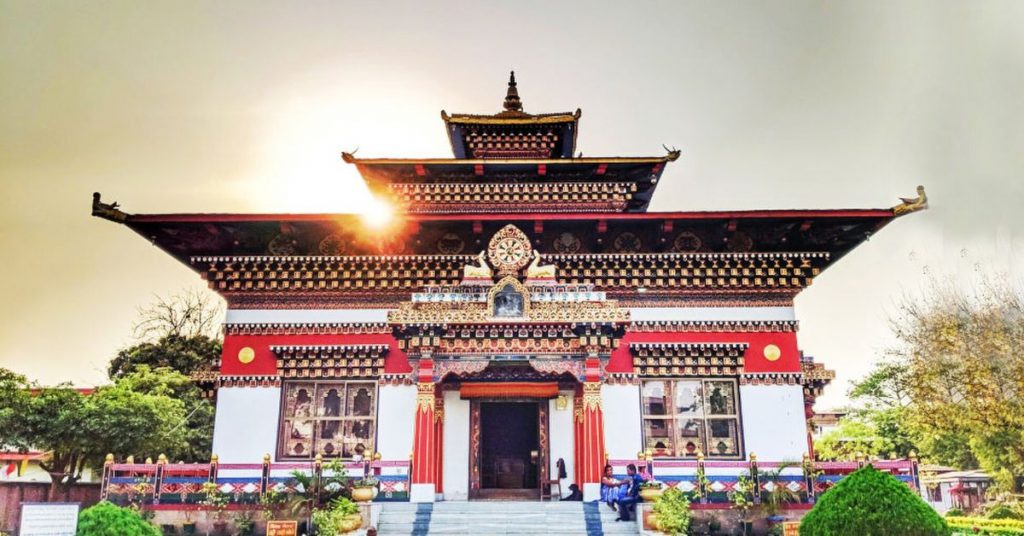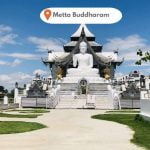Explore the serenity of Buddhist monasteries in Bodhgaya, India – a sacred pilgrimage site with rich heritage, meditation retreats, and spiritual enlightenment.
Bodhgaya, the spiritual nucleus of Buddhist pilgrimage, is revered globally as the place where Siddhartha Gautama attained enlightenment beneath the Bodhi Tree. Nestled along the banks of the Phalgu River in Bihar, this sacred town draws thousands of seekers each year—not only to the Mahabodhi Temple but also to explore the magnificent Buddhist monasteries built by various countries that preserve and celebrate their unique traditions of the Buddha’s teachings.
Each monastery in Bodhgaya is a living, breathing expression of Buddhist philosophy, art, and architecture, serving both as a spiritual retreat and a cultural bridge. Here’s a comprehensive guide to the most significant Buddhist monasteries in Bodhgaya that every pilgrim and traveler should visit.
Buddhist Monasteries in Bodhgaya

1. Thai Monastery: The Jewel of Theravāda Tradition
The Royal Thai Monastery stands as a symbol of Thailand’s devotion to the Buddha, blending serene Thai architecture with the depth of Theravāda Buddhist practice. With a gleaming sloped roof, golden accents, and a tranquil environment, this monastery exudes peace and simplicity.
Highlights:
- Built in 1956 by the Thai government.
- Offers meditation sessions and dhamma talks.
- Home to resident monks from Thailand.
- Open to visitors seeking cultural insight and prayer.
2. Bhutanese Monastery: Peaceful Refuge of the Drukpa Tradition
The Bhutanese Monastery, also known as Sampheling Monastery, is a picturesque center reflecting Bhutanese Vajrayāna architecture, with intricately painted walls, wood-carved dragons, and prayer wheels echoing sacred mantras.
Highlights:
- Modeled after traditional dzongs (fortress monasteries).
- Hosts prayer rituals and Lama teachings.
- Radiates Bhutan’s deeply spiritual aesthetic.
- Serene environment perfect for quiet contemplation.
3. Tibetan Monastery (Tergar Monastery): A Modern Hub of Meditation
Founded by Yongey Mingyur Rinpoche, the Tergar Monastery is a vibrant center for Tibetan Buddhist study and meditation. It welcomes practitioners of all backgrounds, combining ancient teachings with modern methods of inner training.
Highlights:
- Offers regular retreats on mindfulness and compassion.
- Conducts “Joy of Living” courses open to everyone.
- Beautifully decorated prayer hall with large Buddha statues.
- Home to hundreds of young Tibetan monks.
4. Vietnamese Monastery (Quan Âm Monastery): A Quiet Corner of Zen
Built by Vietnamese devotees, the Quan Âm Monastery is lesser-known but offers a deeply calming presence. With its statues of Avalokiteshvara (Quan Âm) and peaceful gardens, it’s a perfect place for silent prayer and relaxation.
Highlights:
- Simplicity inspired by Zen aesthetics.
- Daily chanting in Vietnamese.
- Statues of the Buddha and Quan Âm Bodhisattva.
- Ideal for quiet individual practice.
5. Japanese Monastery (Indosan Nipponji Temple): Zen in Brick and Stone
The Indosan Nipponji Japanese Temple is a stunning showcase of Zen-inspired architecture. Built in 1972 with support from Japan, its clean lines, wooden pillars, and traditional design reflect the serenity of the Japanese Buddhist tradition.
Highlights:
- Hand-carved wooden interiors and wall murals of the Buddha’s life.
- Monks conduct daily rituals and chants in Japanese.
- Tranquil ambiance reminiscent of Kyoto temples.
- Visitors can attend evening prayers and learn about Japanese Buddhism.
6. Chinese Monastery: Elegance and Devotion Combined
The Chinese Temple and Monastery, located close to the Mahabodhi Temple, captures the grace and grandeur of Chinese Buddhist culture, featuring pagoda-style roofs, guardian lion statues, and dragon carvings.
Highlights:
- Features a massive statue of Shakyamuni Buddha.
- Hosts visiting monks from mainland China and Taiwan.
- Wall art depicting Jataka tales and sutras.
- Meditation halls open for guided sessions.
7. Burmese Vihara Monastery: A Legacy of Theravāda Faith
Established in 1936, the Burmese Vihara is a calm and community-driven center offering study, reflection, and hospitality to pilgrims from Myanmar and other parts of the world. With its neat dormitories and modest design, it echoes the minimalist philosophy of Theravāda.
Highlights:
- Known for community service and Buddhist education.
- Peaceful garden for silent sitting.
- Hosts dhamma talks and celebrations on Burmese festivals.
- Accommodation available for Buddhist practitioners.
8. Karma Temple: An Oasis of the Karma Kagyu Lineage
Belonging to the Karma Kagyu tradition of Tibetan Buddhism, the Karma Temple features stunning frescoes, thangka paintings, and statues of the lineage holders. It is a place for profound Vajrayāna practice.
Highlights:
- Located within walking distance of the Mahabodhi Temple.
- Open to Vajrayāna practitioners for advanced rituals.
- Hosts visiting Rinpoches and lamas.
- Daily prayers and offering ceremonies.
9. Nepalese Monastery (Maha Bodhi Society Nepal Branch)
This monastery showcases Nepalese Buddhist artistry, deeply influenced by Newari architecture. Red bricks, carved wooden doors, and lotus motifs blend seamlessly with sacred chants and spiritual hospitality.
Highlights:
- Statues of the Buddha and various Bodhisattvas.
- Offers teachings in both Nepali and English.
- Hosts Nepali pilgrims visiting the Mahabodhi Temple.
- Conducts devotional events and full moon celebrations.
10. Daijokyo Buddhist Temple (Japan)
Another Japanese marvel, the Daijokyo Temple houses a huge Buddha statue and is often used for chanting ceremonies and spiritual gatherings. The peaceful interiors, incense aroma, and structured chants create a memorable spiritual environment.
Highlights:
- Offers a deeper connection to Japanese Buddhist liturgy.
- Hosts joint interfaith and peace gatherings.
- Ideal for photography and peaceful prayer sessions.
Tips for Visiting Monasteries in Bodhgaya
- Dress modestly and respectfully—cover shoulders and legs.
- Silence is sacred—speak softly or remain quiet inside prayer halls.
- Ask for permission before taking photographs.
- Some monasteries offer free meals or tea to visitors—accept graciously.
- Participate in chanting or meditation sessions if invited.
Best Time to Visit Bodhgaya’s Monasteries
The most spiritually vibrant time to explore Bodhgaya’s monasteries is from October to March. During this season:
- The weather is cool and pleasant for walking.
- International Buddhist gatherings like Kagyu Monlam Chenmo and Nyingma prayers take place.
- Dalai Lama’s teachings often occur in December or January.
- The town becomes a melting pot of global Buddhist traditions.
Conclusion: Embark on a Journey of Peace and Wisdom
Bodhgaya is not only the cradle of enlightenment but also a living mosaic of Buddhist cultures and traditions. Each monastery offers a unique doorway into the spiritual legacy of the Buddha—through chanting, meditation, architecture, art, and human connection. For any pilgrim or traveler, a tour of these sacred spaces becomes more than a sightseeing trip—it becomes a journey into the heart of awakening.
Whether you’re a spiritual seeker, cultural explorer, or casual visitor, the monasteries of Bodhgaya offer profound peace and timeless teachings waiting to be discovered.




